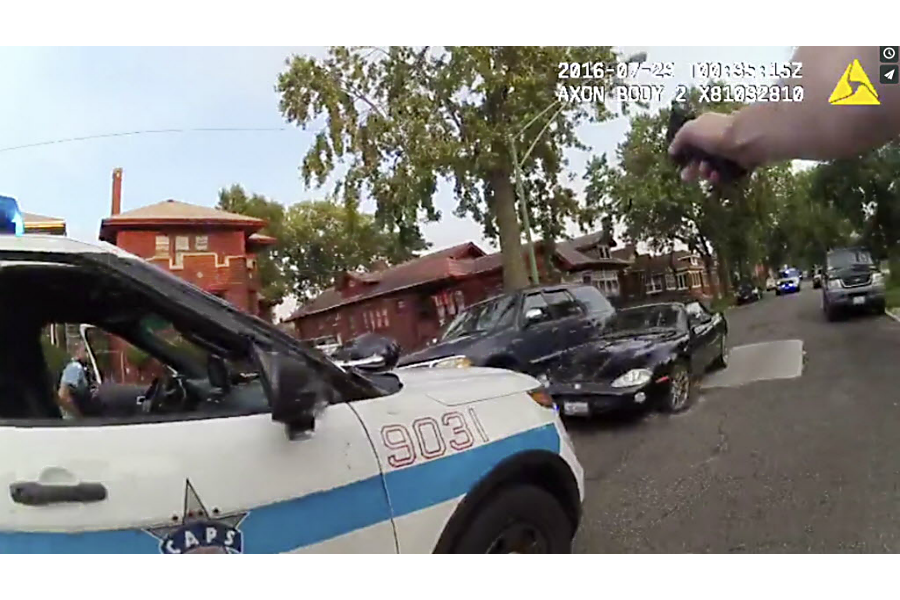Paul O'Neal video: Did Chicago police violate the new shooting policy?
Loading...
Chicago tried to introduce reforms into its police department. It appointed a new police superintendent this spring, revised its policies, and quickly pulled the badges of the three officers that fired at an unarmed black teenager, killing Paul O’Neal July 28.
But, body-camera videos from the shooting suggest the city's actual policing practices haven't caught up to these publicized reforms.
The videos the Independent Police Review Authority (IPRA) released Friday show the three officers fired 15 times at the stolen convertible Mr. O’Neal, 18, was driving, an apparent violation of department policy. The officers’ remarks to each after the shooting, as Mr. O’Neal lays handcuffed and dying on the ground, indicate they fired at the teenager even though they were unsure he was armed.
The images, the first to be released under a new department policy that requires videos of an officer-involved shooting be released within 60 days, are part of Chicago’s efforts to be more transparent, as the US Justice Department investigates it for allegations that it systematically violating citizens’ rights. But, some argue the videos show the department has a way to go before its policing syncs with these reforms.
"This goes down to training on race, this goes down to training on the community," Attorney Michael Oppenheimer, who has sued the department on behalf of the O’Neal family, told The Chicago Tribune. "There's a lot that needs to be done. Some of it has been done. We have a long way to go."
The clash between Mr. O’Neal and police occurred July 28, when the department says he was chased into the South Side neighborhood in a stolen Jaguar convertible. The video shows that after O’Neal crashed into one police SUV and a parked vehicle, two officers fired 15 shots in about five seconds in the direction of a second police cruiser. O’Neal then collides with the second cruiser, and flees on foot. A third officer chases O’Neal. About 20 seconds after the crash, five shots can be heard. The body-camera of the officer who chased O’Neal was not turned on when he is said to have shot O’Neal in the back. The camera turned on afterward, while the officers handcuffed O'Neal.
Police Superintendent Eddie Johnson, a pair of “fresh eyes” Mayor Rahm Emanuel appointed in the spring, said the day after the shooting that it “appears that departmental policies may have been violated.” Because the investigation into the incident is ongoing, police are prohibited from commenting on which policy was violated. In 2015, the department revised its use-of-force policy to prohibit firing on a moving vehicle if it was the only threat against the officers or others.
In the body-camera video, with O’Neal on the ground, one officer says he shot at the car after it almost hit one of the other officers. The officer who said he believed he shot O’Neal said he thought he heard shots come from the Jaguar during the pursuit. He acknowledged he fired without knowing if O’Neal was armed.
A police spokesman said the agency would take a "hard look" at the training and tactics at play in the incident, according to the Tribune.
As the Justice Department investigates the city’s policing practices, Mayor Emanuel and Johnson has attempted to reform the department. In addition to the appointment of Mr. Johnson, Emanuel instituted all officers wear body-cameras. However, the effectiveness of these cameras in improving police practices are up for debate.
The Justice Department has said cameras can improve policing and a department's relationship with the community.
“Body-worn cameras hold tremendous promise for enhancing transparency, promoting accountability, and advancing public safety for law enforcement officers and the communities they serve,” said Attorney General Loretta Lynch last spring, while she announced $23.2 million in grants to aid smaller police departments to buy body cameras.
But a new study of 50 police departments found that the rules that govern camera use, in particular who sees the videos, are more important than just introducing cameras.
“Body cameras are only a step in the right direction,” Chad Marlow of the American Civil Liberties Union (ACLU) told The Christian Science Monitor, “if their use is governed by principles.”







